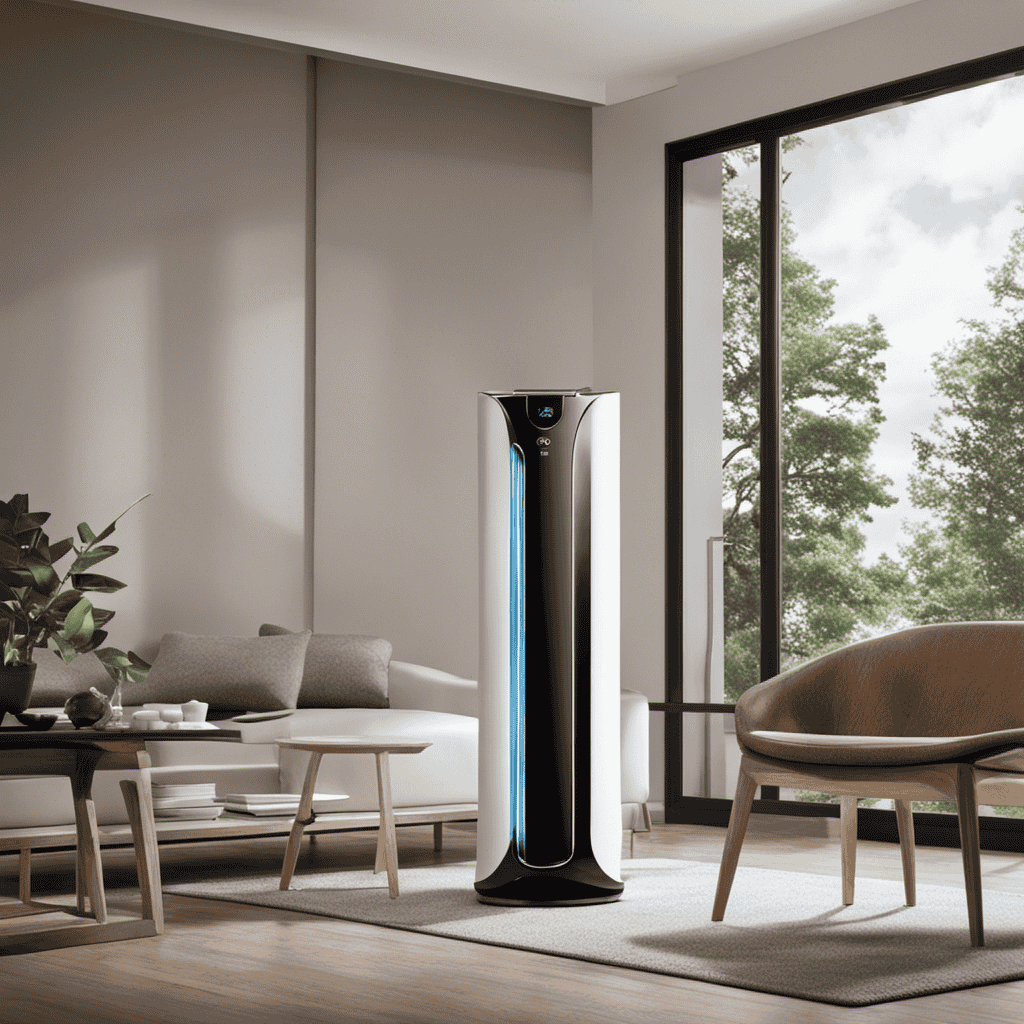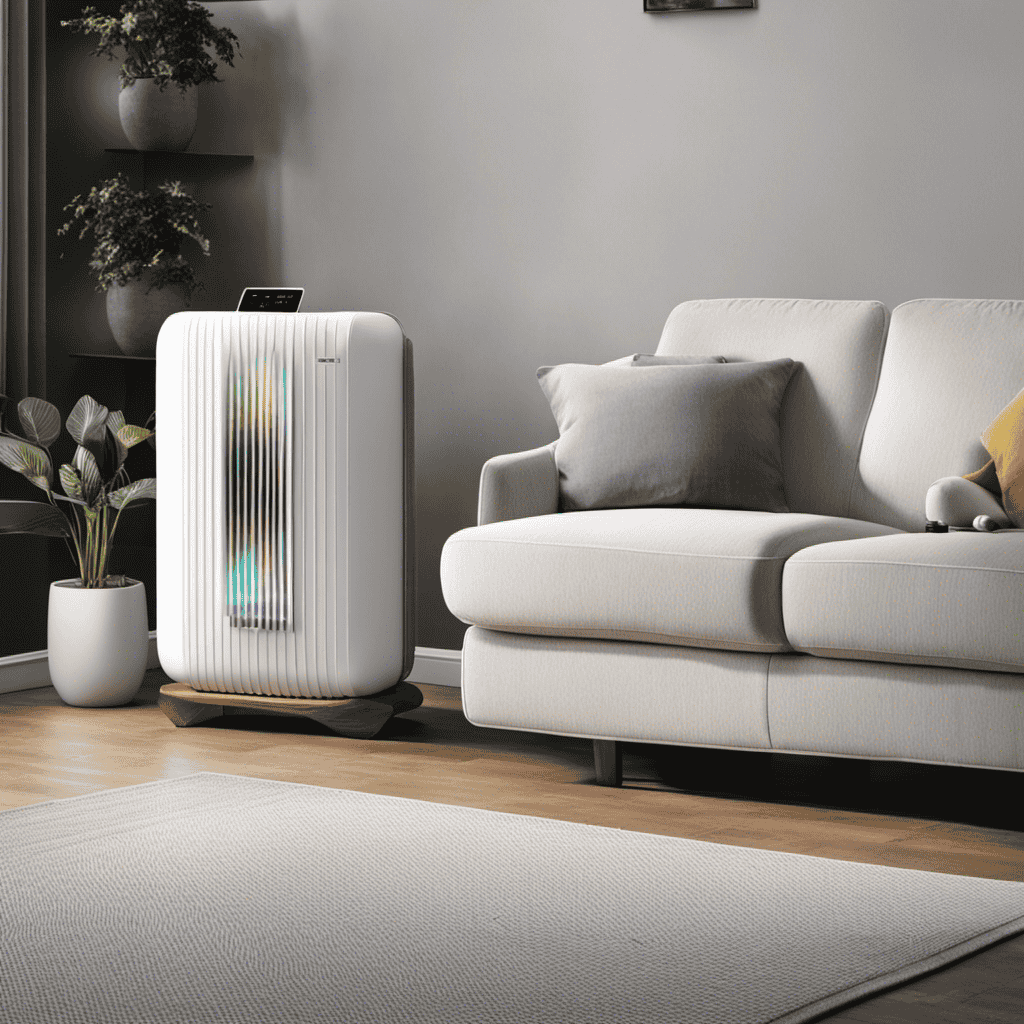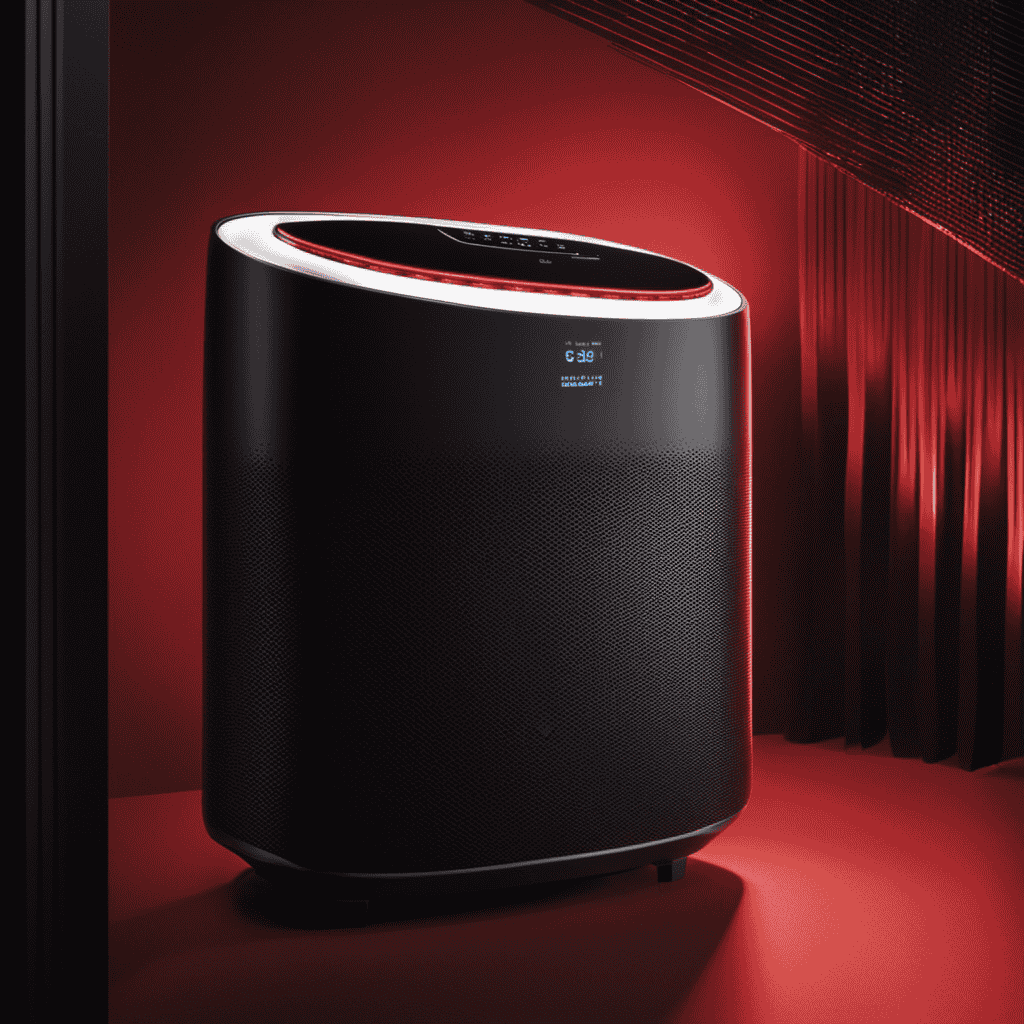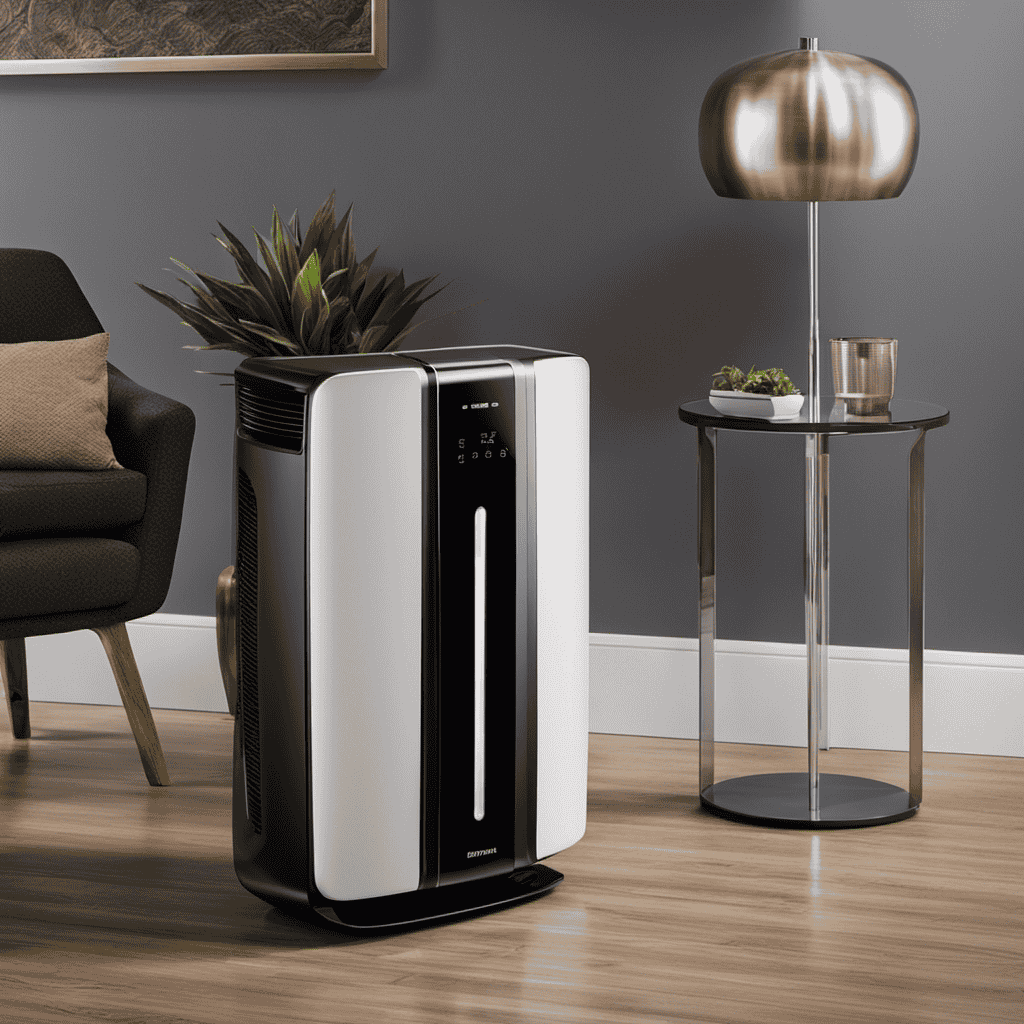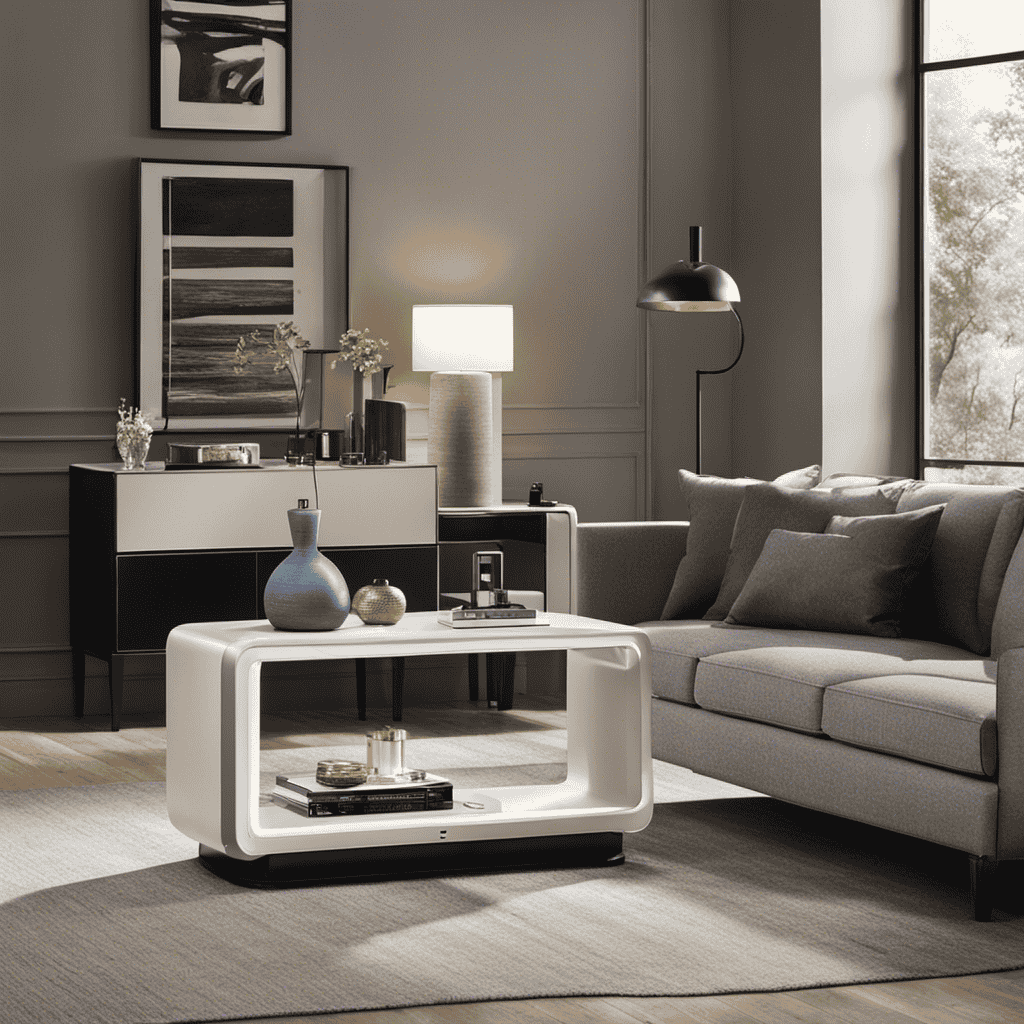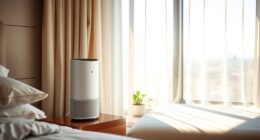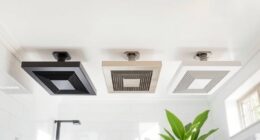When I enter a room, I am immediately struck by the crisp, clean air enveloping me. It feels like a refreshing breeze has whisked away any impurities, creating a peaceful and pure atmosphere.
But have you ever wondered what makes the air in your space so clean? That’s where CADR comes in.
CADR, or Clean Air Delivery Rate, is a crucial measurement in air purifiers that determines their efficiency in removing pollutants.
Let’s dive deeper into the world of CADR and uncover its importance in ensuring the air we breathe is truly purified.
Key Takeaways
- CADR measures the effectiveness of air purifiers in removing smoke, dust, and pollen.
- Higher CADR ratings indicate better removal of particles and improved air quality.
- CADR is crucial for individuals with allergies and respiratory issues.
- Choosing an air purifier with the appropriate CADR ensures effective purification and maximizes health benefits.
Understanding CADR
To understand CADR in air purifiers, you should know that it measures the device’s effectiveness in removing smoke, dust, and pollen from the air. CADR, or Clean Air Delivery Rate, is a measurement technique used to assess the efficiency of air purifiers in improving indoor air quality.
It provides a standardized way to compare the performance of different air purifiers. CADR is determined by conducting tests in a controlled environment where specific amounts of smoke, dust, and pollen are introduced into the air. The air purifier then works to remove these particles, and CADR measures how quickly and efficiently it does so.
A higher CADR indicates a more effective air purifier in removing these pollutants. Understanding CADR and its measurement techniques is essential when choosing an air purifier that meets your specific needs for clean and healthy air.
The Importance of CADR in Air Purifiers
When it comes to air purifiers, understanding the concept of Clean Air Delivery Rate (CADR) is crucial. CADR measures the efficiency of an air purifier in removing pollutants from the air, such as dust, pollen, and smoke.
Choosing the right CADR for your specific needs is important to ensure that the air purifier effectively cleans the air in your environment.
Additionally, CADR has been proven to provide significant health benefits by reducing indoor air pollution and improving overall air quality, leading to better respiratory health and a healthier living space.
Air Purification Efficiency
You can determine the air purification efficiency of an air purifier by checking its CADR rating. The CADR, or Clean Air Delivery Rate, measures how well an air purifier can remove specific pollutants such as dust, pollen, and smoke from the air.
The higher the CADR rating, the more efficient the air purifier is at removing these particles. This is important because effective filtration is crucial in reducing indoor air pollution and improving air quality, especially for individuals with allergies.
Choosing the Right CADR
If you want to choose the right CADR rating, it’s important to consider the size of the room you will be using the air purifier in. Understanding the performance of the air purifier is crucial in ensuring its effectiveness in cleaning the air.
CADR, or Clean Air Delivery Rate, measures the amount of clean air that an air purifier can deliver per minute. It is expressed in cubic feet per minute (CFM). To choose the right CADR, you need to determine the appropriate size of the room and match it with the air purifier’s CADR rating.
A general rule of thumb is to select an air purifier with a CADR that is at least two-thirds the size of the room. This ensures that the air purifier can effectively clean the air and maintain good indoor air quality.
Health Benefits of CADR
To maximize the health benefits of CADR, it’s crucial to choose an air purifier with a high enough rating for your room size. CADR, or Clean Air Delivery Rate, is a measure of an air purifier’s effectiveness in removing pollutants from the air.
By selecting an air purifier with a CADR that matches the size of your room, you can ensure that it effectively improves the air quality and provides numerous health benefits.
Air purifiers with high CADR ratings can significantly reduce the presence of airborne particles such as dust, pollen, pet dander, and smoke, improving respiratory health and reducing the risk of allergies and asthma.
Additionally, a high CADR can also help eliminate harmful volatile organic compounds (VOCs) and other indoor pollutants, promoting a healthier and cleaner living environment.
How CADR Is Measured
When you’re looking at air purifiers, it’s important to understand how CADR (Clean Air Delivery Rate) is measured. CADR is a metric used to determine the efficiency of an air purifier in removing pollutants from the air. To measure CADR accurately, standardized testing procedures have been established by organizations like the Association of Home Appliance Manufacturers (AHAM). These testing standards ensure that CADR values are consistent and reliable across different air purifiers.
The CADR is determined by measuring the rate at which the air purifier can remove three specific types of pollutants: smoke, dust, and pollen. The higher the CADR values for these pollutants, the more effective the air purifier is at removing them.
Here is an example of how CADR is measured:
| Pollutant | CADR Value (in cubic feet per minute) |
|---|---|
| Smoke | 300 |
| Dust | 250 |
| Pollen | 200 |
These values indicate that the air purifier is capable of removing 300 cubic feet of smoke, 250 cubic feet of dust, and 200 cubic feet of pollen per minute.
Understanding how CADR is measured is essential when choosing an air purifier that meets your specific needs for clean and healthy air. Now let’s explore the factors that can affect CADR in air purifiers.
Factors Affecting CADR in Air Purifiers
One important factor affecting CADR in air purifiers is the size of the room it’s being used in. The CADR, or Clean Air Delivery Rate, measures the efficiency of an air purifier in removing pollutants from the air.
Factors that can affect CADR include:
- Room size: Larger rooms require air purifiers with higher CADR ratings to effectively clean the air.
- Pollutant type: Different air purifiers are designed to target specific pollutants, such as dust, pollen, or smoke. The CADR can vary depending on the type of pollutant being filtered.
- Air exchange rate: The rate at which air is circulated and filtered by the purifier affects its CADR. Higher air exchange rates result in faster removal of pollutants.
Understanding these factors is crucial in choosing the right air purifier for your space. By considering room size, pollutant type, and air exchange rate, you can find an air purifier with the appropriate CADR to effectively clean the air in your specific environment.
Finding the Right CADR for Your Space
When it comes to choosing an air purifier, it’s important to consider the optimal CADR levels for your space.
CADR, or Clean Air Delivery Rate, measures the effectiveness of an air purifier in removing pollutants from the air.
The optimal CADR levels vary depending on the size of the room and the specific air quality concerns you have.
Optimal CADR Levels
To ensure you have the best air purification, make sure the CADR levels are optimal. CADR, or Clean Air Delivery Rate, measures an air purifier’s efficiency in removing airborne particles. The optimal CADR range depends on the size of your space and the level of air pollution.
Here are some key points to consider regarding optimal CADR levels:
-
CADR testing methods: CADR is determined through standardized testing methods conducted by independent laboratories. These tests measure the purifier’s performance in removing smoke, dust, and pollen particles from the air.
-
Optimal CADR range: The optimal CADR range for a specific room size is calculated based on the recommended air changes per hour (ACH). A higher CADR value translates to a faster and more effective purification process.
-
Room size and CADR: For smaller rooms, a CADR of 100-150 is generally sufficient. Medium-sized rooms may require a CADR of 150-250, while larger rooms or open spaces may need a CADR of 250 or higher.
Ensuring optimal CADR levels will help you achieve cleaner and healthier air in your living or working environment.
Room Size Considerations
When it comes to choosing an air purifier, room size limitations are an important factor to consider.
The Clean Air Delivery Rate (CADR) is a measure of an air purifier’s effectiveness in removing pollutants from the air. Different air purifiers have different CADR ratings for different-sized rooms.
It is crucial to select an air purifier with a CADR suitable for the size of the room you intend to use it in. If the CADR is too low for a large room, the air purifier may not be able to effectively clean the air, leading to poor performance.
On the other hand, if the CADR is too high for a small room, the air purifier may be overly powerful, resulting in unnecessary energy consumption.
Considering room size limitations in relation to performance expectations will ensure that you choose the right air purifier for your needs.
Importance of Air Quality
The importance of having clean air in your home cannot be overstated. Breathing in polluted air can have detrimental effects on your health and well-being. Here are three key reasons why air quality is crucial:
-
Air pollution effects: Indoor air contaminants, such as dust, pet dander, and volatile organic compounds (VOCs), can cause respiratory issues, allergies, and even contribute to the development of chronic diseases like asthma and lung cancer.
-
Health risks: Poor air quality can lead to headaches, fatigue, and difficulty concentrating. Long-term exposure to indoor pollutants can also weaken your immune system, making you more susceptible to illnesses.
-
Quality of life: Clean air promotes a healthier and more comfortable living environment, allowing you to rest better, think clearer, and enjoy a higher quality of life overall.
Considering the harmful effects of air pollution, it is crucial to take steps to improve air quality in your home. Transitioning into the subsequent section about ‘tips for improving CADR efficiency in air purifiers,’ we can explore effective ways to achieve cleaner air for a healthier home.
Tips for Improving CADR Efficiency in Air Purifiers
One way to improve CADR efficiency in air purifiers is by regularly cleaning or replacing the filters. Filters play a crucial role in the air purification process by capturing and trapping airborne particles.
Over time, these filters can become clogged with dust, allergens, and other pollutants, which can hinder the airflow and reduce the effectiveness of the air purifier. By cleaning or replacing the filters on a regular basis, you can ensure that the air purifier is operating at its optimal capacity.
This will not only improve the airflow within the system but also enhance its ability to reduce pollutants in the air. Regular maintenance of the filters is essential to maintain the efficiency and effectiveness of your air purifier.
Frequently Asked Questions
Can CADR Be Used to Compare the Efficiency of Air Purifiers With Different Filtering Technologies?
CADR is important in selecting air purifiers as it measures their efficiency in removing pollutants. However, it cannot be used to compare purifiers with different filtering technologies as factors like room size, pollutant type, and fan speed affect CADR measurements.
How Does CADR Affect the Removal of Specific Pollutants Such as Pollen or Pet Dander?
Having a high CADR in an air purifier greatly impacts indoor air quality. Factors like the size of the room, filter efficiency, and airflow rate affect how well it removes specific pollutants like pollen or pet dander.
Are There Any Health Risks Associated With Using an Air Purifier With a High Cadr?
Using an air purifier with a high CADR can have health benefits by effectively removing pollutants. However, long-term effects depend on the specific air purifier and its filtration system. Regular maintenance is important to ensure optimal performance.
Can CADR Values Change Over Time as the Air Purifier Gets Older?
Can CADR values change over time as the air purifier gets older? Absolutely! CADR values can vary based on the air quality of the environment and can also be affected by the maintenance and cleaning of the air purifier.
Is There a Recommended CADR Range for Different Room Sizes?
There is a recommended CADR range for different room sizes. It is important to consider the size of your room when choosing an air purifier. Comparing CADR efficiency can help you make an informed decision.
Conclusion
In conclusion, CADR, or Clean Air Delivery Rate, is a crucial factor to consider when choosing an air purifier. It measures the efficiency of an air purifier in removing pollutants from the air. By understanding CADR and its importance, we can make informed decisions to ensure we have clean and healthy air in our homes.
So, next time you’re in the market for an air purifier, ask yourself, ‘How important is clean air to me and my loved ones?’ It is essential for our overall well-being and respiratory health.
